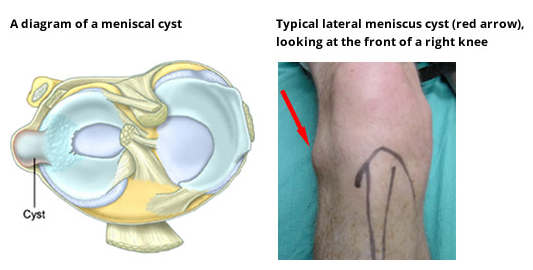A meniscal cyst is generally an uncommon occurrence that causes pain and disability in the knees. It is often seen with meniscal tears occurring because of degenerative alteration within the meniscus. The meniscus is a cartilage pad generally serving as a shock absorber, providing stress transmission and enhancing the lubrication in the knee.
When the meniscus is torn a cyst develops adjacent to the tear. This cyst is thought to develop as a part of the healing process of the body. So a meniscal cyst is a joint fluid’s (synovial fluid) collection caused by a tear with meniscus cartilage which is the joint pad over the knee. Mostly it is found in 20 to 30 years old males as compared to the females.


CAUSES
- Though the release of joint fluid that is synovial fluid is a natural healing response for an injury, still if released in an uncontrolled manner or at the wrong location in excess it can cause pain. This happens as the body continuously makes new joint fluid absorbing the excess and that fluid if escapes the joint, it gets collected in a pouch shape known as a meniscal cyst.
- The sports including the twisting and turning of the leg like tennis, football or rugby cause the meniscal cartilage to be torn and people involved in such sports develop meniscal cyst readily.
- Patients with past knee injury specifically the ligament injury are prone to have a degenerative meniscus tear in high frequency. Rotation of the knees excessively and inappropriate force or pressure on the knees while running too causes this.
- With the increase in age, it is common as the bones become weak and prone to the breakdown in meniscal cartilage.
Any of the above cases may result in a tear of the meniscus and finally into a meniscal cyst.
SYMPTOMS
Generally, the meniscal cyst is asymptomatic sometimes not even showing any pain or swelling. But depending on the intensity of released excessive synovial fluid and the size and site of its origin various symptoms can be observed.
- The most common one is the pain in that focus area where the cyst is released. The person observes the sharp pain while walking, running or even just standing on that leg. The symptoms also increase with prolonged sitting with the knees bent in a particular shape.
- Swelling along the joint line of the leg too is visible. Occasionally a painless bump also appears there, although in this condition the cyst becomes more visible as the knee extends while a movement is being done.
- Tenderness along the joint of the knee, popping and locking may also be present. A certain amount of joint stiffness is also felt by the patient. Basically, the pain is sharp and is felt more with the swelling in the leg. In certain cases, the patient reports serious pain rating 8 out of 10 on the NPRS (numerical pain rating scale) localized to the lateral side of the knee along with intermittent burning or tingling too.
Further based on these symptoms the doctor is able to diagnose the intensity of the condition of meniscal cyst.
DIAGNOSIS
If there are certain symptoms that indicate meniscal cyst a visit to the physician is a must. The physician will enquire specifically related to the knee pain, popping sounds and any recent or past injury related to the knee. After observing the present symptoms he will further suggest an MRI confirm if a meniscal cyst has really occurred or not.
Meniscal cyst generally can be palpated so the doctor will then test the knees’ range of motion to ensure that no pieces of cartilage are trapped in the joint. Many of the cysts are nonpalpable and in these patients having knee pain, an MRI can demonstrate the meniscal tears as well as the cyst.
An MRI gives a clear picture of the size and even the location of a meniscal tear. It also shows ligament, meniscal cartilage and the tendons. The meniscal cyst can be diagnosed easily on MRI by the presence of a vertical line of increased signal intensity contacting the superior, inferior or even both the surfaces of the knee.


TREATMENT
To lessen the pain resulting from it applying ice on the affected area at specific time intervals will help out. Secondly, anti-inflammatory medicines like ibuprofen and naproxen also reduce pain. The synovial fluid may be treated or drained with a large-bore needle under a physician’s supervision. The cyst may usually return if the tear does not heal itself completely. In the case of communicating meniscal tear arthroscopic treatment is required whereas in the non-communication one open surgery will be needed.
PREVENTION
- Giving the knee muscles plenty of rest between the activities like regular exercise.
- Strengthening the muscles around the knee as strong leg muscles will help to stabilize and protect the knee, avoiding meniscal tears and also for stopping the excess release of synovial fluid.
- Avoiding swift knee motion especially in the old age too can prevent the occurrence of a meniscal cyst.
